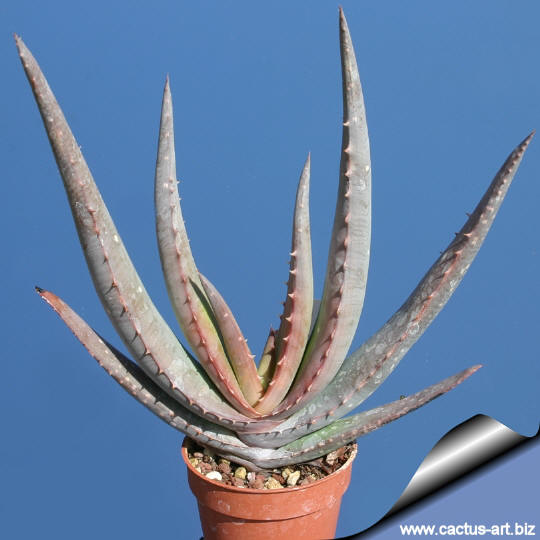|
Family: Asphodelaceae
Scientific name:
Aloe chabaudii
Schönland
Common Names include: Chabaud's Aloe
Origin: Northeastern South Africa to Zambia and
Malawi
Habitat: Grows
on lower slopes of hills on rocky granite outcrops often in dense
colonies..
Etymology: Named after Mr. John A. Chabaud,
of Port Elizabeth, South Africa, ,a well-known enthusiastic amateur
gardener.ì
Synonyms:
- Aloe nitens
- Aloe pycnacantha
|
|

Description: Aloe
chabaudii is a perennial rosette forming succulent up to
40-60 cm tall that offsets freely to form extensive groups in suitable
habitat. It is a robust fast
growing aloe with very showy flowers in winter.
Leaves: In a compact spiralled rosette at the
stem apex in old plants, but in juvenile plants they are ranked in
vertical rows. They are broad, tapering,
lanceolate-attenuate, without spots, pale grey-green to
blue-turquoise, which in full sun and in winter can take a pinkish-red
tinge. Leaves margins with small pungent, deltoid
teeth.
Roots: It has a spread-root-system the roots are somewhat fleshy.
Stem: Stemmless, occasionally a short stem
Flowers: The inflorescence is a 50 - 100 cm tall multibranched
panicle with up to 15 racemes the flowers are small of coral pink or red
at tip of each branch. The flowers are tubular. The perianth is sub-clavate
to clavate, sklightly decurvedand restricted above the ovary.
Blooming season: Flowers in mid winter.
Cultivation: Easy
to grow, requiring very little care. It can be grown in large
containers. Always use a good quality, loamy sandy soil with plenty of
drainage chips at the bottom of containers. It tolerates weekly watering
in the summer; once a month, or not at all in the colder months of
December and January. Can withstand long periods of drought, but they
will thrive and flower more profusely if watered in the correct season.
Incorrect watering, poor drainage or too much shade can lead to attack
by pests and diseases. They can take a few degrees of frost in winter as
well, but prefer hot summers. It grows much better outdoors in spring
and summer.
In mild climates it can be cultivated outdoors for use in landscaping,
preferably planting it in hot and dry rock gardens. They will grow best
in regions with a climate close to that of their native deserts
not too cold, and not too wet.
They grow slowly, but not agonisingly so being able to increase their
height by 10- 30 (or more) cm per year under favourable conditions.
Propagation: Almost
exclusively by seeds planted in autumn, in trays of coarse river sand.
Truncheons (if available) can also be used for propagation. Truncheons
must be dried out for at least 3 weeks before planting in river sand.
This is quite a difficult alternative and success is not always
guaranteed.
Uses:
- Gardening: This tree can be grown in
large, rocky, well-drained soil in gardens in drier areas. It is very
drought resistant but susceptible to frost. Aloe chabaudii
adapts well to a variety of soils and climates. It makes an excellent
ground cover, grows best in a sunny position and makes a long lasting
cut flower.
|